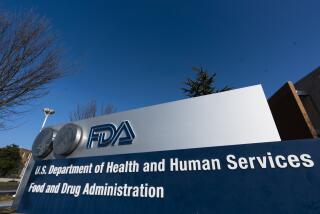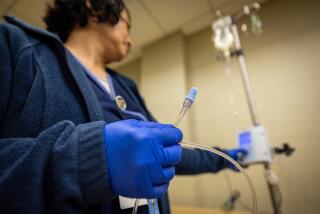‘Unavoidable Accident’ Is Blamed for Drug Test Deaths : Medicine: Panel of doctors clears researchers who were studying hepatitis treatment. The findings contradict an earlier federal probe.
WASHINGTON — Disagreeing with the findings of an earlier federal investigation, an advisory panel of private physicians appointed by the National Institutes of Health has labeled the deaths of five hepatitis patients using an experimental drug as “an unavoidable accident.”
The controversy, which has shaken the world of biomedical research, involved people with chronic hepatitis who had been taking a drug known as fialuridine, or FIAU, in a clinical research project sponsored by the NIH. The deaths of a third of the 15 patients who were on the drug in 1992 and 1993 occurred weeks after their last dosages, authorities said.
Last month the Food and Drug Administration, concluding a study of the tragedy, said scientists, physicians and drug maker Eli Lilly & Co. had failed to fully disclose the drug’s potential risks or to take note of its ominous side effects.
But the new study released Thursday by an NIH panel of outside experts found no fault with those who developed the drug or administered it to chronically ill patients who had volunteered for the research project.
David R. Challoner and David M. Kipnis, who headed the panel of seven physicians asked to determine what went wrong, said in a report to NIH Director Harold E. Varmus that the deaths resulted from “delayed drug toxicity” and could not have been foreseen.
“The subcommittee emphasizes that it could not see itself having concluded or acted differently from the investigative team or the patients, given the information available at each step,” the report said. Challoner is vice president for health affairs at the University of Florida and Kipnis is a professor of medicine at Washington University in St. Louis.
The panel said, however, that U.S. scientists must do a better job of checking for drug toxicity by testing patients for six to nine months after they have taken certain experimental drugs. But it said that should not be done for all drug trials because of the expense.
Challoner said his panel’s study has been forwarded to the FDA. Because that agency and the NIH are both divisions of the Department of Health and Human Services, the department’s assistant secretary for health will be asked ultimately to develop a federal position on the controversy. The drug in question no longer is being used, although research on it is continuing.
One reason for the conflicting conclusions, Challoner said, was a difference in approaches by FDA investigators and the NIH panelists. He said his panel focused on the quality of the clinical research project while the FDA found faults based on records kept by those who conducted the research.
Kipnis said the recent FDA report, for example, criticized some physicians for failing to report abdominal pains experienced by some people taking the new drug. But he said interviews by panel members found that the doctors conducting the study believed that “abdominal discomfort did not reach the degree of severity to be reported.”
Dr. Richard F. Corlin, another panelist, said there was “no pattern of new symptoms” by most patients using the drug that was distinguishable from symptoms they were experiencing from hepatitis itself.
He said the panel also found, contrary to the FDA report, that “no patients felt any lack of attentiveness” by their physicians and that all patients were warned that their lives could be at risk if experimental drugs were taken.
Dr. Jay Hoofnagle, the NIH’s lead investigator of FIAU, was criticized by the FDA for alleged “significant violations” of federal regulations. But the panel’s report defended him.
“Dr. Hoofnagle was enthusiastic about the possibility of developing an efficacious treatment for hepatitis B. However, his approach was careful,” the panel said.
Last November, as a result of the failed drug trial, the FDA adopted new drug-testing regulations that were proposed by an internal review task force. The new rules require researchers to gather and report more data on potentially adverse effects of trial drugs and to assume that any medical problems in patients may be caused by the test drug.
Challoner said if researchers had suspected “delayed toxicity” from administering FIAU, they should have monitored patients for longer periods after the dosages stopped. “But there was no reason to suspect this,” he said.
Hepatitis B, which scientists hoped could be cured by FIAU, is regarded as a significant global problem. Caused by a virus, the ailment is believed to infect an estimated 300 million people worldwide--5% of the population--primarily in Africa and Asia, particularly China.
In the United States, about 300,000 new cases of infection are reported each year, while 4,000 to 5,000 Americans die from the chronic effects of the infection--cirrhosis of the liver, liver failure and liver cancer. Like AIDS, it is transmitted primarily through blood transfusions, sex and sharing contaminated hypodermic needles.
Kipnis said FIAU probably caused genetic damage to the sub-units of liver cells, causing the next generation of cells to die. This would explain why FIAU’s side effects did not appear until long after patients took the drug, he said.






